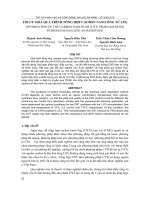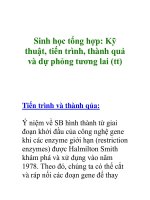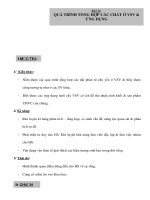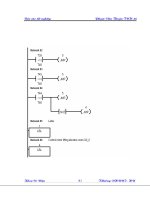QUÁ TRÌNH TỔNG HỢP SYNGAS, QUÁ TRÌNH FISCHER – TROPSCH
Bạn đang xem bản rút gọn của tài liệu. Xem và tải ngay bản đầy đủ của tài liệu tại đây (998.19 KB, 37 trang )
GAS TO LIQUIDS
TECHNOLOGY
NHÓM 3
NGUYỄN NGỌC LIÊM
CAO TRUNG TÍN
HOÀNG ĐỨC THÀNH
60501439
60502945
60502593
NỘI DUNG CHÍNH
GIỚI THIỆU CHUNG
QUÁ TRÌNH TỔNG HỢP SYNGAS
( CO + H2 )
QUÁ TRÌNH FISCHER – TROPSCH
ỨNG DỤNG
GTL process using the Fischer Tropsch method
GTL process using the Fischer Tropsch method
GIỚI THIỆU CHUNG
Gas to liquids(GTL) is a refinery process
to convert natural gas or other gaseous
hydrocacbons into longer-chain
hydrocarbons such as gasoline or diesel
fuel
Methane-rich gases are converted into
liquid fuels either via direct conversion or
via syngas as an intermediate
GIỚI THIỆU CHUNG
Chuyển hoá các khí than ướt (CO và H2) và khí tự
nhiên thành nhiên liệu lỏng có hiệu quả kinh tế luôn là
vấn đề thời sự và cũng là ấp ủ sáng tạo của biết bao
thế hệ nhà bác học, nhà phát minh và các công ty ngay
từ đầu thế kỷ 20
Lần đầu tiên vào năm 1902, hai nhà khoa học Sabatier
và Senderens công bố phương pháp chuyển hoá CO và
H2 thành metan. Hơn hai chục năm sau Fischer và
Tropsch đã phát triển một loại xúc tác dựa trên cơ sở
niken và coban để tổng hợp hydrocacbon nặng (mạch
dài) từ CO và H2
GIỚI THIỆU CHUNG
Ngày nay con đường đầy “chông
gai” kia đã đi đến đâu
????????
QUÁ TRÌNH TỔNG HỢP SYNGAS
1. KHÁI NI ỆM CHUNG
◦ Syngas (from synthesis gas) is the name given
to a gas mixture that contains varying amounts
of cacbon monoxide and hydrogen
◦ Syngas is also used as an intermediate in
producing synthetic petroleum for use as a
fuel or lubricant via Fischer-Tropsch synthesis
and previously the Mobil methanol to gasoline
process.
QUÁ TRÌNH TỔNG HỢP SYNGAS
KHÍ TỔNG HỢP (SYNTHETIC GAS)
MỘT SẢN PHẨM TRUNG GIAN
QUAN TR ỌNG
QUÁ TRÌNH TỔNG HỢP SYNGAS
2. CÁC PHƯƠ NG PHÁP TỔNG HỢP :
◦
◦
◦
◦
STEAM REFORMING
KHÍ HÓA THAN
OXY HÓA KHÔNG HOÀN TOÀN
ĐI TỪ BIOMASS
QUÁ TRÌNH TỔNG HỢP SYNGAS
QUÁ TRÌNH TỔNG HỢP SYNGAS
A. STEAM REFORMING
When used as an intermediate in the largescale, industrial synthesis of hydrogen
(principally used in the production of
ammonia), it is also produced from natural
gas (via the steam reforming reaction)
QUÁ TRÌNH TỔNG HỢP SYNGAS
QUÁ TRÌNH TỔNG HỢP SYNGAS
QUÁ TRÌNH TỔNG HỢP SYNGAS
B. KHÍ HÓA THAN
Syngas for use as a fuel is most often
produced by gasification of coal mainly by
the following paths:
C + H2O → CO + H2
QUÁ TRÌNH FISCHER – TROPSCH
Introduction
◦ The Fischer-Tropsch process (or FischerTropsch Synthesis) is a catalyzed chemical reaction
in which synthesis gas (syngas), a mixture of carbon
monoxide and hydrogen, is converted into liquid
hydrocarbons of various forms
◦ The principal purpose of this process is to produce a
synthetic petroleum substitute, typically from coal,
natural gas or biomass, for use as synthetic
lubrication oil or as synthetic fuel
QUÁ TRÌNH FISCHER – TROPSCH
QUÁ TRÌNH FISCHER – TROPSCH
QUÁ TRÌNH FISCHER –
TROPSCH
Process chemistry
◦ The Fischer-Tropsch process involves a
variety of competing chemical reactions,
which lead to a series of desirable products
and undesirable byproducts. The most
important reactions are those resulting in
the formation of alkanes.
QUÁ TRÌNH FISCHER – TROPSCH
These can be described by chemical
equations of the form:
QUÁ TRÌNH FISCHER – TROPSCH
Process conditions
◦ The Fischer-Tropsch process is operated
in the temperature range of 150-300°C
(302-572°F)
◦ Higher temperatures lead to faster
reactions and higher conversion rates, but
also tend to favor methane production.









